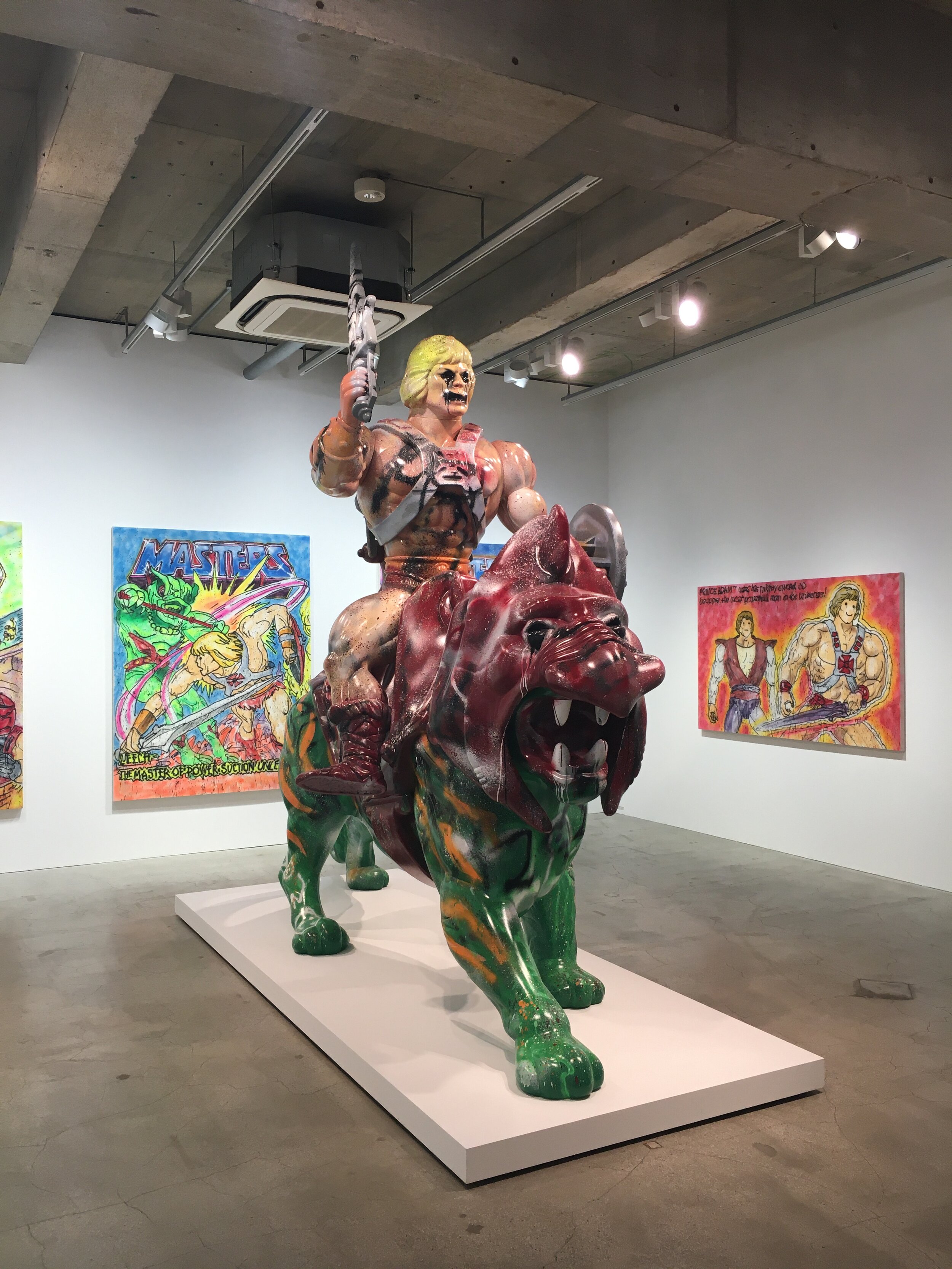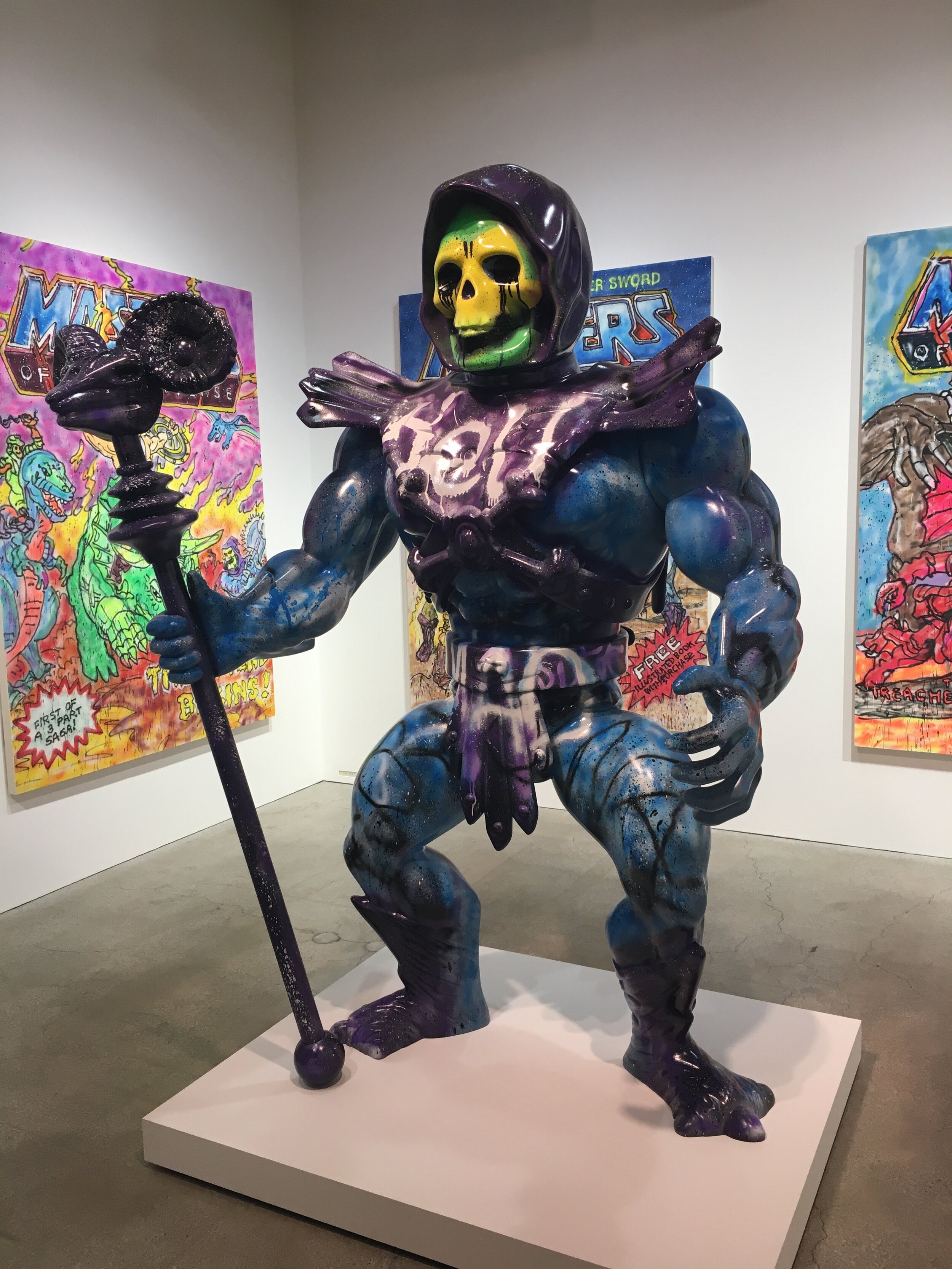I stared into the eyes of the solidified form of my childhood and realised the horrifying truth: instead of carefree imaginings, the era had been one of limitless soul-sucking darkness and despair.
It had definitely been worth the journey across Tokyo to check this out.
The exhibition was held in the Kaikai Kiki Gallery; a small brightly lit space that the website noted was only open when hosting special displays of works by a particular artist. The artist in question now was MADSAKI; a name that appears to be perpetually written in capitals to reassure you that the loss of your soul is all in the name of art. MADSAKI had created models and paintings of He-Man and other characters from the sword and sorcery “Masters of the Universe” franchise.
Like many 1980s kids, I grew up glued to the TV adventures of He-Man; the powerful alter-ego of Prince Adam who transforms into the hero by raising his sword and bellowing “By the power of Grayskull!” and losing most of his clothes. The latter is presumably the explanation for few recognising the blond muscles as the same individual, despite both being accompanied by the only tiger in the series.
The expansion in 1985 introduced She-Ra; the twin sister of He-Man who had been kidnapped at birth and raised in a parallel dimension by an entity known as Hordak. Despite being the head of an evil intergalactic army, Hordak had a progressive view of gender stereotypes and She-Ra (still as her alter-ego, Adora) was a high-ranking captain of troops. After becoming She-Ra by flailing around another sword with the words “For the honour of Grayskull!”, Adora/She-Ra switches sides and begins a spin-off series in the same franchise. Together, He-Man and She-Ra acted out stories of moral fibre and physical strength too great to be confined by any kind of trousers.
The reincarnation of that wholesomeness was now facing me in the form of a giant sculpture of He-Man riding his armoured tiger and wielding his sword. Except… the eyes had been spray painted to become black, dripping voids of soulless defeat. Let’s take a close-up look at what I’m talking about:
Could this reflect the harsh reality every 80s child had to embrace in the cold 2020s that even seemingly good decisions may turn out to be what destroys all hope in the world? Was I staring at the corruption of my inner child? WAS THAT REALLY NECESSARY?
No.
As if to off-set this horror, the walls were decked with paintings of the series characters and Masters of the Universe comic book covers. In each one, He-Man wore a childlike smile that was a poor reflection of the carnage erupting around him but perhaps correctly reflected his lack of soul. Each image displayed the eyes as black dripping dots.
While the exhibition had no written descriptions to accompany the productions, an introduction on the website explained that MADSAKI had moved from Japan to the United States when he was six. Unable to speak English yet, he spent a lot of his time alone watching cartoons. It was through being glued to his favourite Masters of the Universe series that he ultimately learnt the language. And presumably, lost his soul. Or feasibly, he exchanged it in a pact to enable him to understand American football.
While the picture had no caption, this is presumably the young MADSAKI sitting with his favourite characters.
The art works are created with spray paint, explaining the slightly wobbly style and simple lines. Given the tools, they’re pretty incredible. This also potentially explains both the dripping on the black dotted eyes the shadowed hollows on the He-Man sculpture that make this recognisably part of the same art style.
It might explain it. It does not excuse it.
The sculpture construction is also a reflection of the 1980s, mimicking enlarged versions of the action figures from that period with obvious seams where clunky plastic joints connect to the main body. Both He-Man and his arch enemy, Skeletor, had models, both with dripping, black eyes (click the right arrow on the top photo to see both figurines). However, as Skeletor’s face is already a bare skull, the effect is somehow less horrific on the bad guy.
The exhibit was entitled “1984”, the year that MADSAKI mastered English and the peak popularity of the Masters of the Universe franchise. It also recalls another famous literary piece by the same title. This is acknowledged in the exhibit introduction but not satisfactorily explained. My suspicion is the true link between the two is the resulting re-evaluation of the world around you will lead to the destruction of your sanity.
Overall: would highly recommend to both friend and enemy.





